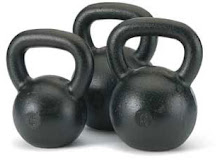The NY Times did a great piece on how kettlebell training can actually cure, and alleviate the symptoms of, back pain. Here it is:
Kettlebells, cast-iron weights that have been used for centuries to train Russian soldiers and athletes, appear to be a promising therapy for back and neck pain, new research shows.
Although many people with backaches and other pains shy away from weight lifting for fear of hurting themselves, studies show that strength training can reduce pain and prevent reinjury. While most research has used traditional weight training exercises, researchers in Denmark set out to study whether a kettlebell workout offered therapeutic benefits to back pain sufferers.
The weights, named for their resemblance to a tea kettle with a looped handle, began showing up in American gyms about 15 years ago and have gained a popular following among exercise buffs looking for a quick full-body workout. Unlike traditional weight training, which typically focuses on lifting exercises, a kettlebell workout requires both swinging and lifting of the weights, which for beginners can be awkward and difficult to control.
In a study published last year, the Danish researchers recruited 40 pharmaceutical workers, mostly middle-aged women with back, shoulder and neck pain, who were randomly assigned to either a regular kettlebell workout or a control group that was simply encouraged to exercise. The first group trained with kettlebells in 20-minute sessions two to three times a week for eight weeks, according to the report, published in The Scandinavian Journal of Work, Environment & Health.
At the end of the study, the kettlebell exercisers reported less pain as well as improved strength in the trunk and core muscles, compared with the control group. Over all, working out with kettlebells reduced lower back pain by 57 percent and cut neck and shoulder pain by 46 percent.
The study’s senior author, Lars L. Andersen, a government researcher in Denmark, noted that workers who spend much of the day sitting are particularly vulnerable to back, shoulder and neck pain because they develop tightness and weak spots along the posterior muscle chain, which includes the muscles running from the lower back down to the glutes, hamstrings and calves. Kettlebell workouts strengthen the posterior muscle chain, and the increased blood flow to the back and leg muscles also may lessen pain by reducing the buildup of lactic acid, the authors wrote.
While isolation exercises like curls and presses have their benefits, kettlebell movements recruit multiple muscles and teach the body “to move as one unit,” said J.J. Blea, a certified kettlebell instructor and an owner of Firebellz in Albuquerque, one of the top kettlebell gyms in the country.
Because kettlebells can be difficult to control, it’s important to learn proper form from a certified instructor or a kettlebell class at a gym. The cornerstone of the kettlebell workout requires the exerciser to swing the kettlebell between the legs. In the Danish study, women started with a 17.5-pound kettlebell and men with a 26.5-pound kettlebell.
“When you’re doing a swing, you squeeze your quads, you squeeze your glutes, and you squeeze your abs,” said Mr. Blea. “By squeezing these muscles, you protect your back. It creates power, and it increases strength.”
Kettlebell training is also surprisingly aerobic. A study by the American Council on Exercise found that a 20-minute kettlebell workout burns about 21 calories a minute, the equivalent of running at a six-minute-mile pace.
Here is the original post online: http://well.blogs.nytimes.com/2012/01/26/turning-to-kettlebells-to-ease-back-pain/?emc=eta1
Wednesday, February 1, 2012
Subscribe to:
Post Comments (Atom)



Good article, but not the best photo...
ReplyDelete